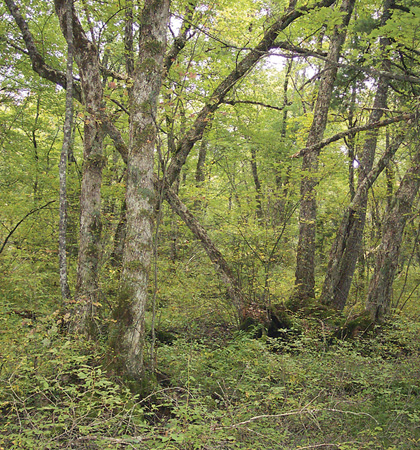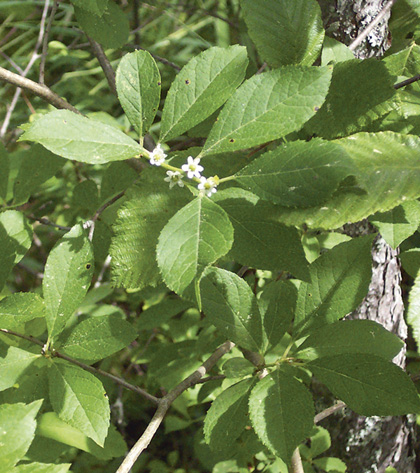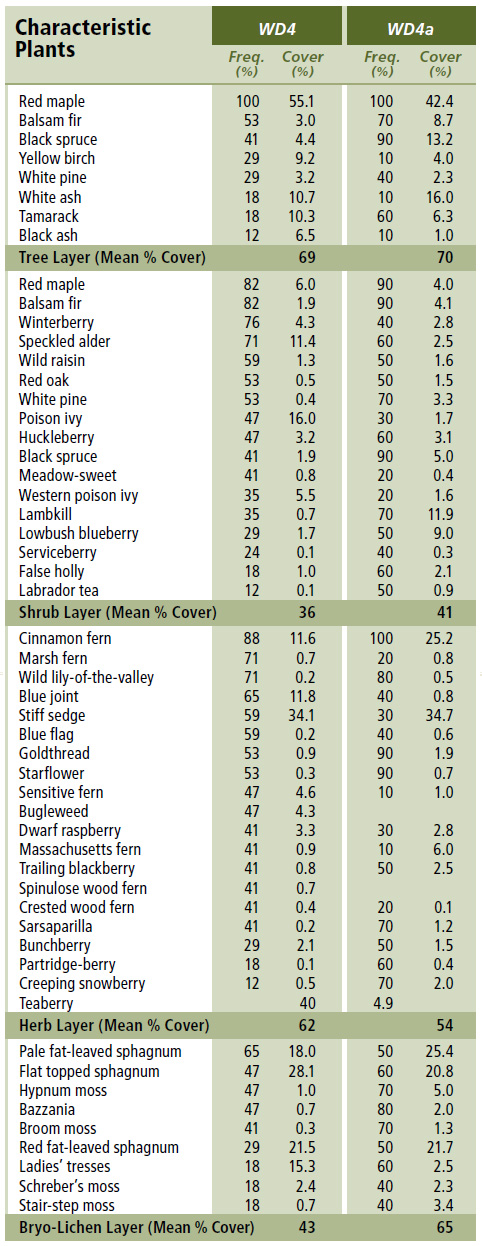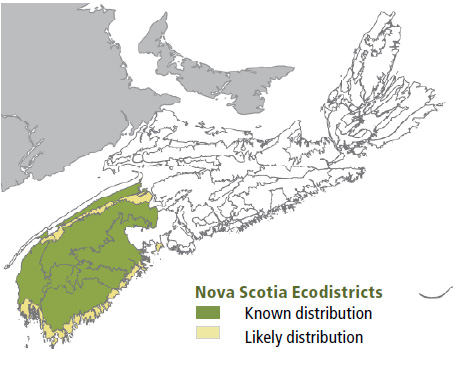
Forest Vegetation types - WD4
WD4 — Red maple / Poison ivy / Sphagnum
Acer rubrum / Toxicodendron radicans / Sphagnum spp
WD4a — Huckleberry – Inkberry variant
Gaylussacia baccata – Ilex glabra.
 |
Sixth Lake Stream, Queens County |
Concept: This Vegetation Type (VT) is distinguished from other wet red maple forests (WD2 and WD3) by the presence of Atlantic Coastal Plain flora like poison ivy, catbriar, inkberry, Elliot’s goldenrod and other plants. WD4 is found in wet organic depressions or on wet mineral flats, where it persists as an edaphic climax. Small- to intermediate-scale disturbances, including windthrow, flooding, ice-scour and timber harvest are common components of stand history.
Vegetation: Canopy layers are strongly dominated by red maple or co-dominated by red maple and black spruce. Mixedwood occurrences are defined by WD4a. In some stands, low to moderate levels of balsam fir, tamarack and/or hemlock may be supported. Black ash and/or white ash are infrequent canopy components. The well-developed woody understory is largely comprised of regenerating trees and poison ivy with scattered pockets of winterberry, speckled alder and/or huckleberry. Cinnamon fern is the only frequent wetland herb. Other coastal plain species (e.g. inkberry, catbriar, highbush blueberry, Elliot’s goldenrod, Massachusetts fern, skunk cabbage, button sedge, Virginia chain fern, Torrey’s Sphagnum, etc.) seldom co-occur with great frequency but at least one or more species is usually represented in each stand. Bryophyte cover is very high and usually dominated by pale fat-leaved sphagnum and flat top sphagnum.
Environmental Setting: WD4 is mainly found in western Nova Scotia, often adjacent to larger rivers and/or lakes. This low elevation ecosystem is usually on poorly drained flats or in shallow depressions, with moderate exposure. WD4 can be found on riverside or lakeside alluvium (floodplain) deposits or on glacial tills, but most stands develop on organic deposits. Low surface microtopography, exposed bedrock and surface stoniness are typical. This forest is not known outside Nova Scotia, but could occur in southwestern New Brunswick.
Successional Dynamics: This forest is usually expressed at mid-successional stages and persists as an edaphic climax. It is maintained by small- to intermediate-scale canopy disturbances (e.g. windthrow, flooding, ice-scour and timber harvest) and limiting site conditions. Depending on disturbance history and local conditions, WD4a could also transition to WC7a (Tamarack – Black spruce / Lambkill / Sphagnum variant Huckleberry – Inkberry) or even CE1a (Eastern white cedar / Speckled alder / Cinnamon fern / Sphagnum variant poison ivy). Windthrow, harvesting and flooding are potential stand-level disturbance agents, while natural senescence can create uneven age class and stand structures between larger disturbance events.
Ecological Features: WD4 supports more Atlantic Coastal Plain flora (ACPF) than any other VT in Nova Scotia. ACPF are temperate plants largely known from an expansive and relatively flat area along the southeastern seaboard of the United States. Although the coastal plain only extends north to Massachusetts, many ACPF occur in small, isolated areas of Canada including the Atlantic Coast and inland areas of western Nova Scotia. Productivity, surface water accumulation, and structural heterogeneity of this ecosystem are variable, but most occurrences are at least moderately productive, supporting well-developed canopy features, moist micro-depressions and tall patches of ferns. Stands along slow moving rivers are prone to ice scour as well as longer periods of flooding and soil saturation. Numerous rare plants have been documented from this small patch ecosystem. Canopy tree senescence and uprooting are often followed by vigourous stump sprouting, which may support a uniquely persistent and poorly understood form of old growth.
 |
| Winterberry |
Distinguishing Features: This wet red maple forest is typically found only in the western counties with a moderate to highly developed woody shrub component including poison ivy, speckled alder, huckleberry and meadow-sweet. Atlantic Coastal Plain plants are often present; usually found next to lakes, rivers and large streams. Cinnamon fern and sphagnum mosses are common.
| Slope Position: | Level8 Depression1 Lower1 |
Surface Stoniness: |
(Non - Slightly)8 (Moderately)1(Very - Excessively)1 |
Bedrock Outcrop: |
(Non-rocky)10 |
Elevation Range: |
21 - 155m |
Slope Gradient: |
Level9 Gentle1 |
Aspect: |
None9 Other1 |
Exposure: |
Moderate5 Mod. sheltered2 Mod. exposed2 nd1 |
Microtopography: |
Level7 Slightly2 nd1 |
Drainage: |
Very poor7 Poor3 |
Soil Type: |
ST148 ST42 |
Parent Material: |
Organic8 Alluvium1 Glacial till1 |
Rooting Depth (cm): |
(<30)4 (30-45)3 nd3 |
Duff Thickness (cm): |
(6-20)1 (21-40)2 (>40)2 nd5 |

